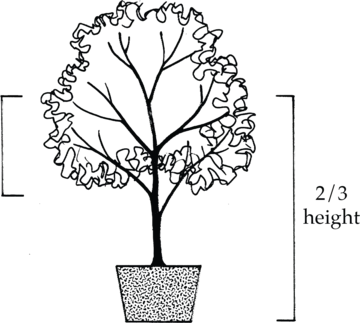Este material también está disponible en español.
Whether you are beginning a new landscape or renovating an existing one, planning ahead can prevent many problems. The majority of maintenance requirements and plant problems result from either selecting the wrong kind of plant for a location or planting an inferior specimen of the selected plant type. In other words, there are two decisions to be made:
- What species, or kind, of tree are you going to buy—an oak, pine, mesquite, or acacia?
- Assuming you decide on an oak, which one in the row of oaks at the nursery are you going to buy? The first decision is called Plant Selection and the second is Selecting Plants. Our goal is to install the right plant in the right place. This publication will cover the factors involved in making good decisions to achieve this goal.
Plant selection
To choose a type or species of plant you need to consider the characteristics of the site and the intended function of the plant. These will help you decide which plant characteristics would be most desirable. Following are the steps to analyze the site where the new plant will be located.
Site characteristics
Above ground
The most important consideration, and the one most often overlooked, is the available space. Know the size and shape of above ground space at the property. Accurately measure and make a scale drawing of your site. Know heights of walls and eaves. You will want to avoid plants that outgrow the space on your site. See Figure 1.

Figure 1: Example of scale drawing of property showing available space for plants
Below ground
The roots of a mature tree or shrub extend 1.5 to 4 times the width of the canopy. For example, the root system of a tree with a 30 ft. wide canopy could be 45 to 120 feet wide. Obviously, many trees grow with roots confined to a much smaller area. Still, it is a mistake to put a large tree with a broad root zone in a narrow planting bed, such as in a parking lot median. See Figure 2.
Consider the utilities. Do not plant near underground utility lines or severe root damage may occur if utility repairs become necessary. Call Blue Stake to locate underground utility lines on your property. Know the approximate underground space available and the location of all underground utilities, including water pipes.

Figure 2: Root zones for most trees, wide and shallow.
Climate
Climate zones can be very helpful in deciding which plants are suited for your landscape. Sunset Magazine describes five climatic zones in Arizona . The US Department of Agriculture publishes a cold hardiness map, based on average annual minimum temperature, which can be useful in higher elevations.
Microclimates may further restrict the types of plants that can be grown in a location. Numerous microclimates may be present on one property. The middle of a parking lot, for example, will be hotter than the surrounding area due to heat radiating from the asphalt. The valley floor at the base of a mountain is often colder due to cold air flowing down from higher elevations. Likewise, the north and east sides of a building will be cooler than the south and west sides. Know your climatic zone and whether the site is especially cold or hot for that zone. See Figure 3.

Figure 3: Typical drawing of a property showing several
microclimates.
Dry or wet locations
Some parts of the site may be subjected to drought or flooding. Examples of dry locations might include the end of a drip irrigation circuit or the middle of a poorly spaced sprinkler system. The area next to a hose faucet or the lowest point in the landscape may be wet. You may also be considering a site that is intentionally not irrigatedor periodically flooded.
Exposure
Less sunlight will be available on the north and east sides of a structure than on the south and west sides. Some plants will take the full sun of a southern exposure, but not the reflected light and heat on the west side of a building. Any existing trees will throw a shade pattern that moves through the seasons. Classify the site as being in the shade, part shade, full sun, or reflected sun.
Soil depth
Eighteen inches to three feet of soil is adequate for trees and shrubs. Consider adding soil if you have less than six to eight inches.
Soil texture
Soil can be a sand, a silt, a clay, or some combination of these three, called a loam. Sandy soils drain well, are well aerated, and resist compaction, but do not hold water or nutrients well. Clay soils do not drain well, are poorly aerated, and easy to compact. However, clay soils hold water and nutrients very well. Silty and loamy soils are between these extremes. See Figure 4.
Plants that require a well-drained soil generally do well in sand or sandy loams. Those that prefer a fertile soil may do better in a soil which contains higher amounts of silt or clay.
Know the soil texture at your site. A nursery consultant or Cooperative Extension Master Gardener can estimate texture from a two to four cup soil sample.

Figure 4: Three mineral components of a soil–sand, silt and clay
are determined by the diameter of the particle.
Soil compaction and drainage
Most urban soils are compacted to some degree. Pedestrian traffic is often to blame. Compacted soils limit water penetration, air exchange, and root growth. Flood irrigation also compacts clay-type soils. Many desert plants require a well-aerated soil and do poorly in compacted sites where water can’t move beyond the root zone.
Drainage may also be influenced by layers in the soil that are relatively impervious to water and air. Bedrock, caliche, or clay layers can all cause poor drainage and restricted air movement. Identify these areas on the site. See Figure 5.

Figure 5: Caliche layers prevent roots and water from
penetrating into deeper soil.
Soil pH (acidity/alkalinity)
The acidity or alkalinity of a soil influences nutrient availability and the presence of some soil pathogens. Most soils in Arizona are alkaline (pH greater than 7.0), but there are some areas of neutral or acid soils. Although some alkaline soils can be made more acid by adding elemental sulfur, this effort must be repeated each season to have any lasting effect.
More importantly, most alkaline soils in Arizona are also calcareous (high in calcium). It is very difficult to change the pH of a calcareous soil. Pour a little acid, such as vinegar, on the soil. If the reaction produces bubbles the soil is calcareous. Grow only those plants that prefer your soil type. Plan to grow acid-loving plants (hibiscus, gardenias, etc.) in large patio containers with artificial potting soil.
Soil salinity
Alkaline soils are often salty. If you see white rings surrounding drip emitters, you may have a salinity problem. For many plants, salinity problems can often be avoided by periodic heavy irrigations if the water is not salty. However, some plants are very sensitive (maples and sycamores) while others are very tolerant (palms).
Soil fertility and toxicity
Sandy soils tend to be low in fertility while clay loams tend to be high. Although most plants adapted to the alkaline soils of the southwest can tolerate infertile soils, it is wise to be aware of potential problems. Iron is often unavailable and can cause citrus, pyracantha and other plants to develop iron chlorosis. An excess of any one nutrient (sodium or boron, for example) may cause toxicity problems in sensitive plants. More information is available in Fertilizing Home Gardens in Arizona.
Pests
Be aware of significant, common insect infestations in your area. Examples might include whiteflies in the Phoenix and Yuma areas, lawn grubs, palo verde borers, agave weevils, seasonal grasshoppers, etc. Cooperative Extension bulletins can give more information.
Know if your soil harbors nematodes, Texas (cotton) root rot, or similar problems. The presence of soil diseases can limit your choices for landscape plants. Cooperative Extension bulletins can give more information.
Probably the most common mammal pests are rodents, deer, gophers, rabbits, elk and javelinas. Under harsh conditions, these animals will probably eat almost any plant or its roots. Under normal conditions these animals may avoid some plants. Rabbits, for example, apparently do not care for apache plume. Read our plant resistance series for help is selecting plants resistant to rabbits and resistant to deer.
Plant function
Size
Review the scale drawing of your lot. Begin to think about mature plant sizes. Do not plan for tall trees, such as palms or big pines, under an electric line, or low, wide trees, such as a palo verde, in a city street median near a sidewalk. A tree or shrub should be placed no closer to a building than one half the mature width. See Figure 6.

Figure 6: Trees and shrubs should be planted where they will
not interfer with buildings, streets or utility lines.
Architectural
Plants that are going to be used as a floor should be dense, low growing, and tolerant of traffic if they are going to be walked on. Some ground covers collect trash or are difficult to weed. See Figure 7.
Plants used as screens should be dense and tall enough to provide a visual barrier. See Figure 8. They may need to be tolerant of hedging. The plant’s final size should allow visibility if it is necessary (ex: at corners of lots).
Plants used as ceilings should be dense and tall enough to walk under without constant pruning. Vines on overhead trellises may be deciduous and thus messy.
Most people probably over-emphasize the aesthetic function of plants when planning their landscape. Opinions will vary as to what is attractive.
Engineering
In the arid Southwest, windbreaks are effective in reducing wind speed and drying effects (allowing for reduced water consumption). Windbreaks should be planted perpendicular to the prevailing wind and should be several rows of different type plants (ex: one row trees, one row shrubs, one row small shrubs). The plants need multiple stems and dense foliage that reaches ground level. Fibrous roots are also helpful for reducing soil erosion. See Figure 9.
Plants used to prevent water erosion, such as on a slope, should be spreading with dense foliage close to the ground and with fibrous roots. See Figure 10.
Plants can be effective in reducing noise, but the belt of vegetation needs to be twenty-five to fifty feet wide. It should have several rows of different plant types, some evergreen and some deciduous. A variety of leaf shapes will mask sounds.
Plants can be used to direct pedestrian traffic. Sometimes simply a dense, thick groundcover will work. For a more substantial barrier, select flexible, dense plants that are multistemmed and/or thorny.
Dense, tall plants are best for blocking unwanted light. If blocking sunlight is a goal, be sure to plan for the movement of the sun throughout the day and throughout the year. See Figure 11. Deciduous trees on the south side will allow low sun to warm the building. Ground covers and low shrubs will cut glare and reflected heat from sandy soil or gravelly areas. See Figure 12.
Climatological
Dense canopies, such as mulberry, may restrict what you can grow underneath. Filtered shade from less dense canopies may be as comfortable while allowing undergrowth. Consider also the natural canopy shape. Compare, for example, the shade cast by an Italian cypress with that from an ash. Again, be sure to plan for movement of the sun throughout the day and throughout the year. See Figure 13.

Figure 13: Shade angles change and overlap as the seasons
progress through the year.
Shading the south or west sides of a home with plants that can take the high light and heat can result in a temperature reduction of several degrees. Cacti cast heavy shadows late in the day. Vines can be supported on cables/ wires/fencing or may climb directly on stucco. See Figure 14.

Figure 14: If tall trees are not possible, lower growing plants
close to the building can provide temperature moderation.
Evergreen plants can redirect cool air flows toward the living area. A single row of these plants can be sufficient under some conditions. See Figure 15.

Figure 15: These evergreen trees are directing air under the
canopy and towards the building.
Special considerations
Plants provide habitat and food for attracting wildlife to your landscape. Conspicuous fruits, both fleshy and dry, will attract birds. Thorny plants provide safe nesting. Showy, nectar-bearing flowers may attract hummingbirds or butterflies.
If growing food is a priority, choose fruiting trees and vegetables for an ‘edible landscape’.
Selecting plants
Once you have decided on the type or species of plant that meets your needs, you are ready to select an individual plant. Here are the factors to keep in mind when selecting this plant. A reputable nursery is your best source of information and will stand behind their products. In the long run, it pays to search out properly grown plants.
Good proportion
Select a plant that is average size relative to the container or root system. Do not pick the largest plant, that may be root bound in the container, nor the smallest, that may not have been in the container very long.
Vigorous and healthy
Many growers tie young trees on nursery stakes for ease of production and transport. The net result of such practice is that a new tree’s trunk may be weak. You, the final consumer, will remove the nursery stake when you plant the tree (See Arizona Cooperative Extension Bulletin #AZ1022 Planting Guidelines: Container Trees & Shrubs). However, the tree may need to be staked for the first year. You can avoid this requirement by looking for trees with strong trunks that can stand alone. Try to find a plant without a nursery stake. Avoid trees with inverse taper (the trunk is wider just below the leaves than at the soil line). See Figure 16.
There should be no evidence of insects or disease. The leaves should be uniform in size and color. There should be no fungal or weed problems in the container. Neither the trunk nor any branches should be bruised, broken, or damaged. Look for bruised, tattered, or torn foliage (a sign of wind drying) and dried, shriveled twigs and buds.

Figure 16: Select good trees in the nursery to avoid problems as the plants get older.
Structure
Many native trees in the southwestern US typically grow from multiple trunks. Look for these species (palo verdes, mesquites, ironwoods, some acacias) to have two or more main trunks (“multi”). Multiple trunks are a little more difficult to produce, because they are less frequently staked. They do tend to be sturdier trees once they are established on the site. Many other tree species grow naturally from a central leader (oaks, ashes, all conifers). For these species, look for a strong, single central leader, straight in the container or root ball, with good taper (wider at the bottom than the top). See Figure 17. For any tree, limbs should be strong and healthy. The branches should be evenly spaced vertically and radially around the trunk(s) with wide branch angles. For all trees, the branches should be evenly distributed along the plant. One half the foliage should be on branches originating on the lower 2/3 of the plant, not concentrated at the top. See Figure 18. Avoid grafted or budded trees with suckers arising below the union. Avoid plants with flowers or fruit (they divert resources that could be used to establish the tree after planting). If you are selecting plants based on a specific flower or fruit color or characteristic, remove the flowers and fruits when planting.
There should be several well-spaced trunks arising from a visible root crown. Again, the foliage should be evenly distributed in the upper two thirds of the plant, not concentrated at the top. Again, avoid plants with flowers or fruit.
Root system
The root crown or flare should be visible. Avoid plants planted too deep in the container. Avoid root-bound plants; there should be few or no roots emerging from the container drain holes. The container media should not be washing out the drain holes. Scratch the surface to see if there are encircling roots; these will cause problems later. There should be no weeds in the container. Roots, if visible, usually should have white tips. With the assistance of a nursery worker remove the plant from the container to inspect the roots. See Figure 19.
Containerized plants are plants that were grown in the field then dug and put in containers. Follow the guides for container grown plants, but also ask how long the plants have been in the containers. Plants that were dug a month or so ago may not be well rooted yet. Those dug a year or more ago may be root bound.
For ball and burlap, the rootball should be compact and firm, not loose or broken. The ball should be moist, but not wet. Given the choice, select a plant with natural fiber burlap, rather than plastic that will not degrade in the soil. Handle B&B plants with care.
With bare roots, there should be fibrous roots visible. The major roots should be fresh, plump (not slimy) and cut cleanly, not broken or crushed. The roots should be moist, but not wet. Select a plant with major roots radiating in three or four directions, equally spaced around the trunk.

Figure 19: Roots should not be spiraling around in the container. (root bound).
Origin
In general, plants grown in a climate similar to yours will adjust more quickly and perform better. Given the choice, select a plant grown locally.









